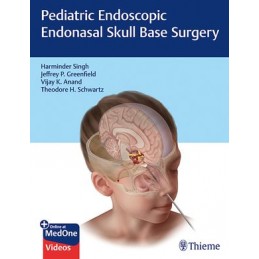- Reduced price

Order to parcel locker

easy pay


 Delivery policy
Delivery policy
Choose Paczkomat Inpost, Orlen Paczka, DHL, DPD or Poczta Polska. Click for more details
 Security policy
Security policy
Pay with a quick bank transfer, payment card or cash on delivery. Click for more details
 Return policy
Return policy
If you are a consumer, you can return the goods within 14 days. Click for more details
The definitive state-of-the-art resource on pediatric endoscopic endonasal approaches
Today, expanded endonasal approaches (EEA) have revolutionized the surgical treatment paradigm for pediatric central skull base lesions. Specially adapted micro-instruments have been developed to permit passage through the narrow sinonasal pathways in children, enabling access to the entire midline skull base, from the crista galli to the cervico-medullary junction.
Pediatric Endoscopic Endonasal Skull Base Surgery by Harminder Singh, Jeffrey Greenfield, Vijay Anand, and Theodore Schwartz is the first textbook focused solely on endoscopic endonasal management of cranial base pathologies in children. The book reflects in-depth expertise from an extraordinary group of international contributors from five continents, who share extensive knowledge on this emerging field. Thirty chapters are presented in three comprehensive sections.
Key Features
This unique reference is essential reading for neurosurgical and otolaryngology residents and fellows, as well as veteran surgeons, nurse-practitioners, and physician-assistants who treat and care for pediatric patients with skull-base conditions.
This book includes complimentary access to a digital copy on https://medone.thieme.com.
Data sheet
Part I Pediatric Anatomy, Approaches, and Surgical Considerations
1 Anatomy of the Developing Pediatric Skull Base
2 Pediatric Rhinologic Considerations
3 Anesthetic Considerations in Pediatric Patients
4 Patient Positioning and Operating Room Setup
5 Instrumentation
6 Intraoperative Neurophysiological Monitoring during Endoscopic Endonasal Skull Base Surgery
7 Endonasal Corridors and Approaches
8 Combined Transcranial and Endonasal Approaches
9 Transorbital and Multiportal Approaches
10 Endonasal versus Supraorbital Eyebrow Approaches: Decision-Making in the Pediatric Population
11 Ventral Approaches to Intraparenchymal Tumors of the Skull Base and Brainstem
Part II Pathology Specific to the Pediatric Skull Base
12 Meningoencephaloceles
13 Sellar Arachnoid Cysts
14 Odontoidectomy for Craniovertebral Junction Compression
15 Rathkes Cleft Cyst
16 Craniopharyngioma
17 Pituitary Adenomas: Functional
18 Pituitary Adenoma: Nonfunctional
19 Epidermoid and Dermoid Tumors
20 Juvenile Nasopharyngeal Angiofibroma
21 Optic Pathway Glioma and Juvenile Pilocytic Astrocytoma
22 Germ Cell Tumors
23 Chordoma
24 Chondrosarcomas
25 Malignant Skull Base Tumors
26 Subperiosteal Orbital Abscess
Part III Skull Base Closure, Complication Management, and Postoperative Care
27 Closure Techniques for the Pediatric Skull Base: Vascularized Flaps
28 Closure Techniques for the Pediatric Skull Base: Multilayer Closure
29 Closure Techniques for the Pediatric Skull Base: Gasket Seal
30 Closure Techniques for the Pediatric Skull Base: Bilayer Button
31 Closure Techniques for the Pediatric Skull Base: Lumbar Drains
32 Complication Management in Pediatric Endonasal Skull Base Surgery
33 Postoperative Care for Pediatric Skull Base Patients: The Neurosurgery Perspective
34 Postoperative Care for Pediatric Skull Base Patients: The Otolaryngology Perspective
Reference: 80464
Author: Robert K. Jackler
